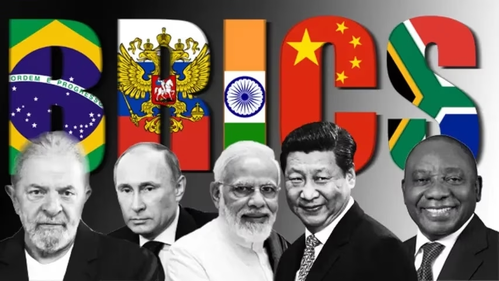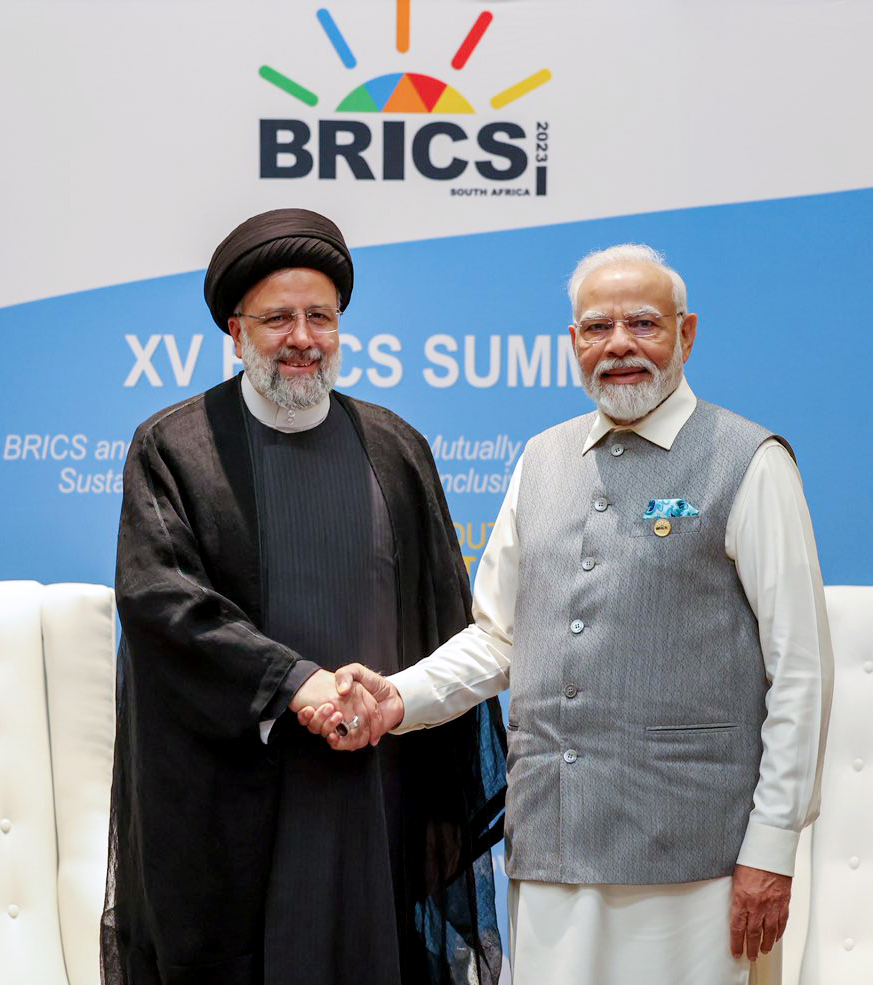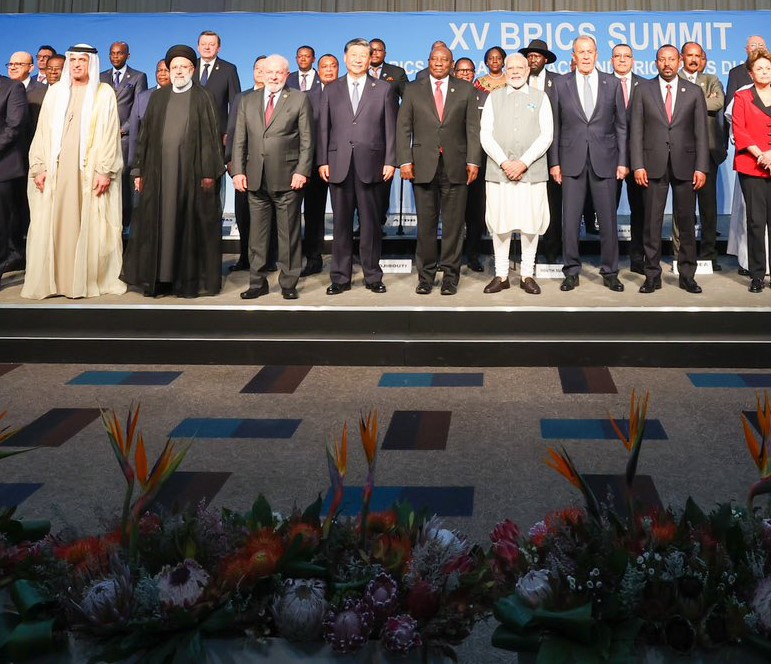
With over 40% of the world’s population and a growing share of the global economy, the BRICS nations have reshaped the international arena. The expansion of BRICS membership, India’s active role, and the promising India-China détente all underscore the group’s dynamic nature. As the summit closed, reaffirming principles of mutual respect, multilateralism, and inclusive development, the BRICS nations showcased their dedication to shaping a more equitable and balanced world order, exemplifying a new paradigm of cooperation among nations of the Global South … writes Dr Maheep
The 15th summit of the BRICS group, which comprises major emerging economies from the Global South including Brazil, Russia, India, China, and South Africa, took place from August 22 to 24 in Johannesburg. The summit occurred at the Sandton Convention Centre (SCC) and was attended by prominent figures such as South African President Cyril Ramaphosa, Chinese President Xi Jinping, Brazil’s President Luiz Inacio Lula da Silva, and Indian Prime Minister Narendra Modi. Notably, this summit marked the first occasion of an in-person BRICS gathering since the onset of the COVID-19 pandemic.
In Johannesburg, Prime Minister Narendra Modi expressed India’s warm welcome for the expansion of the BRICS grouping through a consensus-based approach. During the 15th BRICS summit, he urged member states to leverage India’s digital solutions and collaborate for the betterment of the Global South. India played a pivotal role in forging a consensus on membership criteria and the selection of new members, driven by the objective of including its strategic partners as new members. The BRICS summit resulted in the induction of six new members, indicating a commitment to strengthening this coalition of emerging non-western developing economies. With this expansion, BRICS aims to assert itself as a counter-western grouping and promote comprehensive UN reform, increased intra-BRICS payments in national currencies, space cooperation, and support for India’s G20 Summit. However, India must carefully navigate potential challenges arising from BRICS’ evolving strategic and political dimensions, considering its ties with other global partners like the Quad, SCO, and IPEF.

The New Development Bank is playing a vital role in advancing the development of Global South nations. A financial safeguard has been established through the Contingency Reserve Arrangement. Initiatives such as the BRICS satellite constitution, Vaccine R&D Centre, and mutual recognition of pharmaceutical products are fostering positive transformations in the lives of ordinary citizens across BRICS countries. People-to-people ties among all member countries are strengthened through endeavours like the Youth Summit, BRICS Games, and Think Tanks Council. India had earlier suggested initiatives such as the Railway Research Network, enhanced cooperation between MSMEs, an online BRICS database, and a Startup Forum to steer the BRICS agenda in a new direction.
In view of the satisfactory progress made on those fronts, India has made five new suggestions during the current session. The first is cooperation in the field of space. Work on the BRICS satellite constellation is already afoot. Taking it a step further, a BRICS Space Exploration Consortium may be created. Such a consortium may work for global good in areas like space research, and weather monitoring.
The second suggestion is related to cooperation in education, skill development and technology. To make BRICS a future-ready organization, societies in the member countries must be made future-ready. Technology has a vital role to play in this transition. India has created DIKSHA (Digital Infrastructure for Knowledge Sharing) platform to provide education to the children of remote and rural areas, 10,000 Atal tinkering labs across the country to promote innovation among school students, Bhashini, an AI-based language platform, to remove language barriers and the CoWIN platform for vaccination. Public service delivery is being revolutionized through Digital Public Infrastructure i.e. India Stack. India expressed its willingness to share all these platforms with BRICS partners. They are likely to be useful to the rest of the world since they have already been tested on a highly diverse population.

India’s third proposal involves collaborative skills mapping, where member countries can work together to recognize and leverage each other’s strengths. This synergy will contribute to a shared developmental journey. A fourth suggestion was to join forces through the International Big Cat Alliance, coordinating efforts to ensure their conservation and protection, since various species of Big Cats are available in all the major BRICS countries. The fifth and final suggestion for the BRICS members was to consider if they could work together towards building an international repository of traditional medicine, given that each member boasts of unique systems of traditional healing systems.
India has consistently lent full support to the expansion of BRICS membership. The nation has maintained a steadfast belief that the incorporation of fresh members will fortify the organization’s stature and inject new vigour into joint undertakings. This stride will also bolster the confidence of numerous countries worldwide in the concept of a multipolar world order. Prime Minister Modi was delighted to note the accord reached concerning the fundamental principles, norms, criteria, and protocols for expansion and at the consensus to extend a warm embrace to Argentina, Egypt, Iran, Saudi Arabia, Ethiopia, and the UAE, inviting them into the BRICS fold.
In future, for nations expressing a keenness to join BRICS, India promised to play an active role in fostering consensus to welcome them as partner countries. The expansion and modernization of BRICS communicate a resounding message that all global establishments must adjust to the evolving times. This initiative stands as an exemplar for the transformation of other global institutions established during the twentieth century.
The member states reaffirmed their commitment to upholding the essence of BRICS, characterized by mutual respect and comprehension, sovereign parity, unity, democratic values, transparency, inclusiveness, heightened teamwork, and shared consensus. As they leveraged the progress achieved over 15 years of BRICS Summits, they pledged to further fortify the foundation of advantageous collaboration among BRICS nations, focusing on three core pillars: political and security cooperation, economic and financial collaboration, and cultural and people-to-people exchanges. They resolved to elevate their strategic partnership for the betterment of their respective populations by fostering peace, advocating for a more equitable global order, revitalizing and restructuring the multilateral system, promoting sustainable development, and facilitating comprehensive and equitable growth.
They also reaffirmed their dedication to embracing inclusive multilateralism and preserving international law. This encompasses the fundamental goals and principles outlined in the United Nations (UN) Charter, which serves as an essential foundation. Additionally, we emphasize the pivotal position of the UN within a global framework where independent nations collaborate to uphold peace and security, promote sustainable development, and safeguard the ideals of democracy and human rights.
They called for increased participation of emerging markets and developing countries in international institutions and multilateral discussions where their significance is notable. Additionally, we urge for a heightened presence and participation of women from these regions in various capacities within global organizations.
Meanwhile, India and China appeared to make some breakthroughs on the sidelines of the summit. The Prime Minister of India and the Premier of China reached an agreement to escalate efforts to reduce tensions along their contested border. They also aimed to withdraw their numerous troops stationed in that region, as confirmed by an official from India’s foreign ministry. During an unplanned meeting between Indian Prime Minister Narendra Modi and Xi Jinping, China’s leader, Prime Minister Modi expressed India’s concerns regarding the unresolved border disputes, according to India’s Foreign Secretary Vinay Mohan Kwatra, who briefed Indian journalists. Subsequently, the Chinese Embassy in New Delhi posted a statement from the foreign ministry on Twitter. The statement highlighted Xi Jinping’s emphasis on the mutual benefits of improving China-India relations, which, in turn, would contribute to global and regional peace, stability, and development.

The Role of BRICS
The 15th BRICS summit is a significant milestone for the coalition of major emerging economies from the Global South. This in-person gathering, the first since the pandemic, demonstrated the group’s commitment to collaboration and solidarity. Over the years, BRICS has evolved from an economic acronym to a powerful consortium with a substantial impact on global affairs. With over 40% of the world’s population and a growing share of the global economy, the BRICS nations have reshaped the international arena. The expansion of BRICS membership, India’s active role, and the promising India-China détente all underscore the group’s dynamic nature. As the summit closed, reaffirming principles of mutual respect, multilateralism, and inclusive development, the BRICS nations showcased their dedication to shaping a more equitable and balanced world order, exemplifying a new paradigm of cooperation among nations of the Global South.
The acronym BRIC was introduced by Jim O’Neill, an economist from Goldman Sachs, in 2001 to address the growth of Brazil, Russia, India, and China. The inaugural gathering of the BRIC nations (Brazil, Russia, India, and China) took place in St. Petersburg, Russia, in July 2006, coinciding with the G8 Outreach Summit. This initial meeting was succeeded by the official establishment of the BRIC group in September 2006, solidified during the inaugural BRIC Foreign Ministers’ Meeting. This significant event occurred on the fringes of the United Nations Assembly’s General Debate in New York City.
The BRIC group of nations held their first meeting in 2009 in Russia. With the inclusion of South Africa the following year, the collective began to be referred to as BRICS. Presently, the BRICS countries constitute over 40% of the global population and approximately 26% of the worldwide economy. Annually, they convene for a summit of BRICS leaders to deliberate on matters of political and socioeconomic coordination. This entails exploring business prospects, economic synergies, and other domains of cooperation they have identified.
The primary objective of the BRICS consortium is to collaboratively influence global politics and economics in their favour. They utilize platforms like the BRICS Parliamentarian Forum and Outreach Dialogue to confer and interact with neighbouring regions and other interested nations. As an illustration, South Africa leverages the BRICS platform to emphasize its foreign policy priorities, such as the African Agenda and South-South Cooperation. The economic ties among member countries are reinforced through entities like the BRICS Business Council, the Contingent Reserve Agreement, and the New Development Bank (NDB). The NDB, headquartered in Shanghai, provides funding for infrastructure and sustainable projects within BRICS nations. Meanwhile, the Contingent Reserve Agreement extends short-term financial assistance to members, enhancing financial stability and mitigating payment crises.
In the 21st century, the BRICS coalition has emerged as a formidable bloc of developing economies. Recently, they have outpaced the G7 in terms of their contribution to the global GDP, constituting nearly one-third of the world’s economic activity. In response to economic challenges in the Western world, the BRICS nations even deliberated on establishing their own global currency to reduce the dominance of the US Dollar, which has prevailed since the breakdown of the Bretton Woods system in 1971.
The 13th BRICS Summit took place on September 9, 2021, with India serving as the host country. This marked India’s third occasion of chairing the BRICS Summit, the previous instances being in 2012 and 2016.Traditionally low-key, the BRICS Summits took on a new tone in South Africa in the lead-up to the 2023 summit, marked by a series of international relations controversies. The current host, South Africa, hoped to orchestrate a significant shift in global power dynamics through this prominent gathering. Extending invitations to all African heads of state and garnering interest from approximately 40 countries worldwide, spanning from Argentina to Kazakhstan, this event signifies a noteworthy advance in fostering political unity among Global South nations.
(Dr Maheep is a leading analyst of India’s Foreign Policy. He has been in teaching and research of International Relations and Global Politics over a decade)


